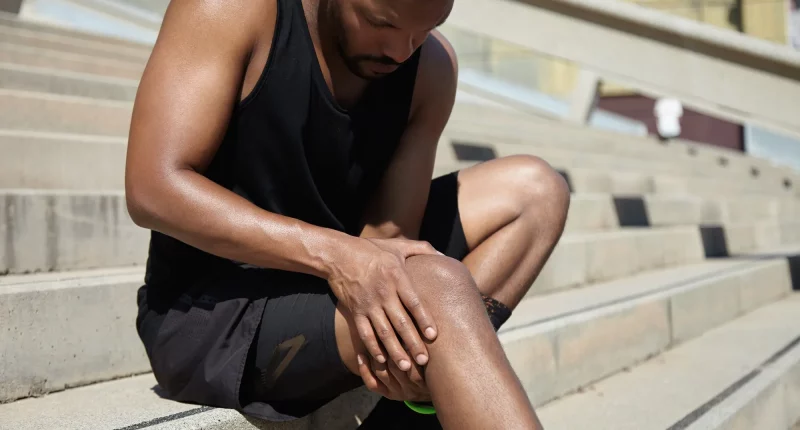The anterior cruciate ligament (ACL) is a crucial part of the knee. Injuring the ACL is a common and serious problem that can be very painful.
The knee is where three bones meet: the thighbone, shinbone, and kneecap. These bones are kept in place by four ligaments, while tendons attach the bones to muscles. Cartilage cushions the knee and helps it move smoothly.
The ACL is one of two ligaments that form a cross inside the knee, linking the thighbone to the shinbone. This connection helps keep the knee stable.
What is an ACL Injury?
An ACL injury happens when a ligament connecting the thighbone to the shinbone, is stretched too much and tears.
This injury often happens during active sports that include a lot of jumping and quick changes in direction. Over 70% of ACL injuries happen without any direct contact or hit to the knee.
In the United States, about 1 in 3,000 people experience an ACL injury. Many of those affected are young and active individuals. ACL injuries are more common in women than in men, even when playing the same sports.
When someone injures their ACL, it’s common for other parts of the knee to be damaged too, such as the tendons, cartilage, and bones.
Symptoms of an ACL Injury
A major sign of an ACL injury is a “popping” sound at the moment the ligament is stressed or torn. This is often accompanied by significant pain.
Other symptoms of an ACL injury include pain and swelling around the knee. You might have difficulty extending your knee fully or feel discomfort when walking. The area around the knee can become sore, and you may find it hard to put weight on the affected leg. Additionally, there’s often a sensation that the knee might give out or feel unstable.
Causes of an ACL Injury
Anyone, regardless of fitness level or age, can injure their ACL, but these injuries typically happen during physical activity. Common causes include sudden stops, starts, or changes in direction, a direct blow to the knee, mainly from the side, and overstretching the knee.
ACL injuries are particularly common in sports that involve a lot of turning and twisting. Activities such as soccer, tennis, football, skiing, and basketball have higher rates of ACL injuries due to the frequent rapid movements and changes in direction they require.
Types of ACL Injuries
Doctors classify ACL injuries based on their severity:
- Grade 1 Sprains: At this level, the ACL is overstretched but can still maintain knee stability.
- Grade 2 Sprains: Known as partial tears, these injuries occur when the ACL stretches to the point of becoming loose.
- Grade 3 Sprains: This is an overall tear of the ligament, where the ACL is torn into two pieces and can no longer control the kneecap.
As stated by the American Academy of Orthopaedic Surgeons, partial tears are less common than complete tears.
Diagnosis of an ACL Injury
To diagnose an ACL injury, a doctor will examine how much the injured knee can move and compare it to a healthy knee. This helps them understand the extent of the injury.
The doctor might also use X-rays to check for any bone damage. For a more detailed look at the soft tissues, such as the ACL, they might use an MRI. This imaging helps them see if there is a tear or other damage to the ligament.
Treatment of an ACL Injury
After an ACL injury, a doctor may suggest several immediate steps to help manage the injury:
- Elevate the Foot: Keep the injured foot above the level of your head to reduce swelling.
- Apply Ice: Use an ice pack wrapped in a towel on the knee to reduce pain and swelling.
- Take Ibuprofen: This medication helps decrease pain and swelling.
- Seek Medical Attention: See a healthcare provider for a full evaluation and treatment plan.
The approach to treatment will depend on the seriousness of the injury, as well as the age and fitness level of the person.
For young and healthy individuals, surgery might be recommended to ensure they can fully return to their activities. ACL surgery involves using small cameras and instruments through tiny cuts, a method called arthroscopy. During the surgery, the damaged ACL is usually removed and replaced with a graft. The graft can be from the patient’s own body, a donor, or it might be synthetic.
Researchers are exploring new methods, like bio-enhanced repair, to make better ACL surgeries and lower the risk of arthritis later on.
If surgery is not needed and the knee remains stable, treatment options may include:
- Using Crutches: To keep weight off the injured knee.
- Wearing a Brace: To support and stabilize the knee.
- Physical Therapy: Exercises to strengthen the leg muscles and restore full movement to the knee.
Recovery from an ACL Injury
For athletes, it can take about 7 to 9 months to fully recover and return to sports. During this recovery period, you might need to use crutches or wear a knee brace to protect and support your knee.
Physical therapy is a key part of recovering from an ACL injury. This therapy involves gentle stretches and strengthening exercises that help in several ways:
- Ease Swelling and Pain: Exercises can reduce pain and decrease swelling in the knee.
- Improve Flexibility and Range of Motion: Stretching helps make the knee more flexible and allows it to move more freely.
- Build Strength: Strengthening exercises target the muscles around the knee and in the upper and lower legs, making them stronger and better able to support the knee.
- Restore Balance: Physical therapy helps improve your balance, making it easier to move confidently and safely.
These steps are important to ensure a full and successful recovery, helping you get back to your regular activities and sports.
Prevention of ACL Injuries
Preventing an ACL injury isn’t always possible, but there are steps you can take to lower your risk:
- Learn Proper Techniques: Knowing the right techniques for jumping, pivoting, landing, and cutting can reduce the strain on your knees. This involves learning how to move efficiently and safely during sports and physical activities.
- Strengthen Leg Muscles: Building strength in your leg muscles, particularly the quadriceps and hamstrings, can help support and protect your knees. Stronger muscles can better absorb impact and provide stability to the knee joint.
- Strengthen Core, Pelvis, and Hips: A strong core, pelvis, and hips help stabilize your body and reduce stress on the knees during movements like jumping and landing. Exercises that target these areas, such as planks, bridges, and hip abduction exercises, can contribute to overall knee health and stability.
By incorporating these preventive measures into your exercise routine and sports training, you can reduce your risk of sustaining an ACL injury and keep your knees strong and healthy.
Outlook
Recovering from an ACL injury can take a long time, but most people can get back to their usual activities with the right care.
However, those who’ve had an ACL tear have a higher chance of getting osteoarthritis in that knee later on.
To lower the risk of more knee injuries in the future, you can:
- Physical Therapy: This helps you regain strength and movement in your knee.
- Strength Training: Building up the muscles around your knee can make it more stable and less likely to get hurt.
- Neuromuscular Training: These exercises focus on improving your coordination and control during movements like jumping and turning, as well as your balance and flexibility.
By doing these things, you can protect your knee and stay active and healthy.
Summary
ACL injuries are quite common and can be really serious. They often happen during sports where there’s a lot of sudden movement like starting and stopping quickly, turning sharply, or jumping. Interestingly, women are more likely to get ACL injuries than men.
Treating an ACL injury might involve just physical therapy and using things like knee braces for support. But for people who are really active, a doctor might suggest surgery.
Getting better after an ACL injury can take a long time, sometimes more than 7 months before someone can get back to playing sports.
If you’ve had an ACL injury, you’re more likely to hurt your knee again in the future. It’s important to be careful and maybe talk to a physical therapist about ways to lower this risk. They can give you tips and exercises to keep your knees strong and safe.









